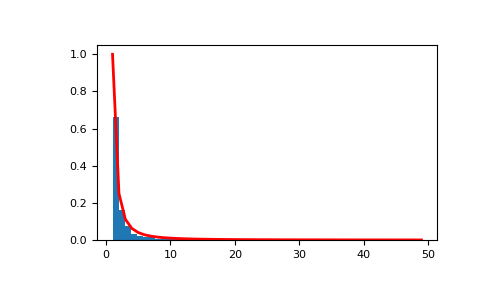numpy.random.RandomState.zipf¶
-
RandomState.zipf(a, size=None)¶ 从Zipf分布绘制样本。
样本从具有指定参数a> 1的Zipf分布中绘制。
Zipf分布(也称为zeta分布)是满足Zipf定律的连续概率分布:项目的频率与其在频率表中的秩成反比。
参数: a:float> 1
分布参数。
size:int或tuple的整数,可选
输出形状。如果给定形状是例如
(m, n, k),则m * n * k默认值为None,在这种情况下返回单个值。返回: samples:scalar或ndarray
返回的样本大于或等于1。
也可以看看
scipy.stats.distributions.zipf- 概率密度函数,分布或累积密度函数等。
笔记
Zipf分布的概率密度为
其中
 是Riemann Zeta函数。
是Riemann Zeta函数。它以美国语言学家乔治·金斯利·齐普(George Kingsley Zipf)的名字命名,他指出语言样本中任何单词的频率与其在频率表中的排名成反比。
参考文献
[R207] Zipf,G.K.,“Selected Studies of the Principle of Relative Frequency in Language”,Cambridge,MA:Harvard Univ。Press,1932。 例子
从分布绘制样本:
>>> a = 2. # parameter >>> s = np.random.zipf(a, 1000)
显示样本的直方图,以及概率密度函数:
>>> import matplotlib.pyplot as plt >>> import scipy.special as sps Truncate s values at 50 so plot is interesting >>> count, bins, ignored = plt.hist(s[s<50], 50, normed=True) >>> x = np.arange(1., 50.) >>> y = x**(-a)/sps.zetac(a) >>> plt.plot(x, y/max(y), linewidth=2, color='r') >>> plt.show()
